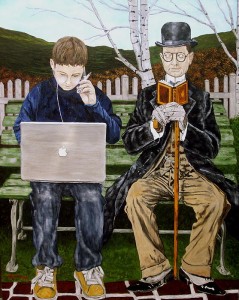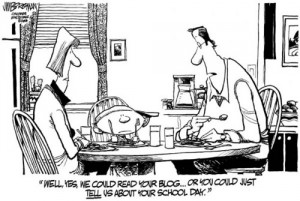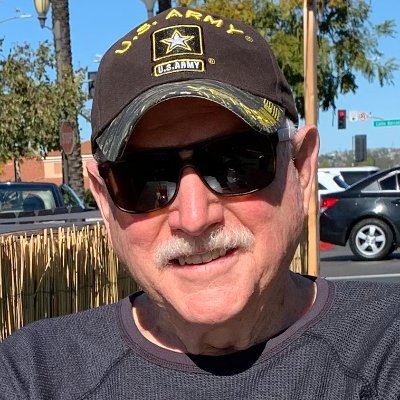 Accomplished wordsmith William Safire once defined a gap between the generations as “a frustrating lack of communication between young and old, or a useful stretch of time that separates cultures within a society, allowing them to develop their own character.”
Accomplished wordsmith William Safire once defined a gap between the generations as “a frustrating lack of communication between young and old, or a useful stretch of time that separates cultures within a society, allowing them to develop their own character.”That’s a pretty good definition. But it doesn’t tell the whole story.
Generation gaps have no doubt existed on this planet since the first homo sapiens appeared about 200,000 years ago. However, the drastic differences that the term implies were not much in evidence until the twentieth century. Before that time humans were not very mobile. Young people typically lived near their extended families, worshiped in their childhood churches and often worked on the family farm or in a family business. In the 19th Century most people lived and died without traveling more than 200 miles from where they were born.
With the advent of television and movies, adolescents were exposed to cultural influences alien to their own families and cultures. Then came the 1960s. Civil rights, women’s liberation and the Vietnam War exposed a more serious chasm between young and old.
 A study released recently by the Pew Research Center found younger and older Americans in 2011 see the world much differently, creating the largest generation gap since the tumultuous years of the 1960s. The study said Americans of different ages are increasingly at odds over a range of social and technological issues. That divide grew greater after the 2008 election, when 18- to 29-year-olds voted for Democrat Barack Obama by a 2-to-1 ratio.
A study released recently by the Pew Research Center found younger and older Americans in 2011 see the world much differently, creating the largest generation gap since the tumultuous years of the 1960s. The study said Americans of different ages are increasingly at odds over a range of social and technological issues. That divide grew greater after the 2008 election, when 18- to 29-year-olds voted for Democrat Barack Obama by a 2-to-1 ratio.Almost eight in 10 people believe there is a major difference in the point of view of younger people and older people today, according to the independent public opinion research group.
The top areas of disagreement between young and old, according to the Pew Research Study, are the use of technology and taste in music. Slightly behind these areas of difference are listed the following:
- Work ethic
- Moral values
- Respect for others
- Political views
- Attitudes toward different races and groups
- Religious beliefs.
There is nothing new here. When I was a teenager Rock and Roll was considered “jungle music” and those who sang and played it were, in the minds of older Americans, little more than savages. Some radio stations wouldn’t play Rock and Roll. Elvis Presley, Chuck Berry, Little Richard and Jerry Lee Lewis were considered evil influences on the youth of the day.
The 1950s were probably the beginning of what we know today as a generation gap. Before then the closets of most teenagers resembled those of their parents. Not so in the 1950s. That decade brought a revolution in styles that pushed the envelope and actually continue to influence fashion today.
A lot of guys combed their hair into greasy Ducktails, wore skin tight jeans and shirts with the collars turned up. It was “the look” of the day.
Girls wore short-shorts, poodle skirts, pony tails, and, if you were lucky, did the “dirty bop” with you. (Believe me, it was tame compared what happens on the dance floor today).
So what’s the big deal about the widening generation gap of 2011 and how does it differ from the gap that existed in the 1960s?
First, the Pew Study said, the two largest areas of difference–technology and music–are less emotionally charged than political issues. The older generation is likely to be proud of the younger generation’s skill in using new technology rather than to view it as a problem. As for the musical differences, each generation wants its own style of music, and the older generation generally can relate to that desire–even if most people older than 50 probably consider rap and hip hop a form of discordant monotone chanting rather than vocal or instrumental sounds organized in some coherent sequence comprised of melody, rhythm and harmony.
In the other areas of difference, the Pew study reported, the younger generation tends to regard the older generation as superior to their own generation–clearly a difference from the 1960s with its rallying cry of “Don’t trust anyone over thirty.”
According to the study, all generations regard older Americans as superior in moral values, work ethic and respect for others. Why are older Americans regarded as superior in moral values, work ethic and respect for others? Does it have something to do with the way many children are reared today? If parents equivocate when it comes to teaching such values to their children then it is not surprising that a generation gap between young and old exists.
And who is at fault for that? The younger generation? I tend to think the fault rests with parents and those charged with educating the young. By the time they are adolescents it is most likely too late to instill in them the values that are revered by older Americans.
One common complaint I hear from older Americans about younger Americans is their reluctance to accept responsibility for their actions.
“It’s not my fault,” is heard all too often from the younger generation. That, however, is a dangerous trap, said Doctors Henry Cloud and John Townsend in their 2007 book (“It’s Not My Fault’) because it not only keeps them from overcoming the effects of all that they can’t control—like other people, circumstances and genetics—but separates them from a solution. And when they give away the ownership of their life, they end up losing the one opportunity they have to fulfill their dreams and enjoy the best life has to offer.
When I was growing up my parents and grandparents simply never endorsed my attempts to use the “blame game” for my mistakes, misfortunes and misdeeds.
“Stop making excuses,” is what I heard. Eventually I did.
I never felt there was a generation gap between my parents and me, perhaps because I respected them and they never gave me a reason not to. If there is an area that can be improved on with young people today that may be it.
Children may be grateful in the short term when parents refuse to impose rules of behavior and inculcate discipline in them. But in the long term I believe they are thankful–even if they may never admit it.
Learning to respect others, to honestly work for what you get in life and to live according to some variant of the Golden Rule (“do not treat people in a way you would not wish to be treated yourself”) may just be the unpretentious bridge that spans the gap between generations.
It certainly beats plummeting into the canyon.



Canyon it is….Everywhere. That’s a problem with the world.